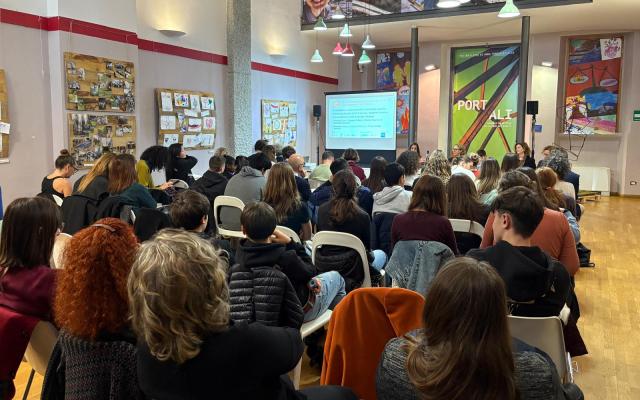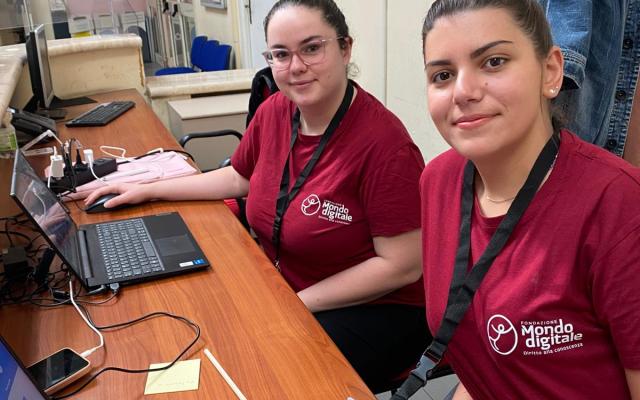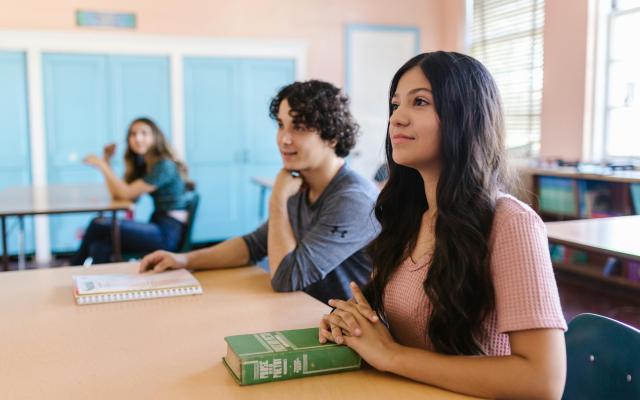Here's how artificial intelligence recounts the inaugural conference
The conference, held today, 7 May, at Roma Tre University, opened with institutional greetings from Rector Massimiliano Fiorucci and Mirta Michilli, Director General of the Fondazione Mondo Digitale. Moderated by Riccardo Luna, journalist at Corriere della Sera, the event was attended by international experts who discussed Pope Francis' legacy on the ethics of artificial intelligence and the “techno-human condition”, a concept he introduced in his speech at the G7 in June 2024.
Among the speakers, Ennio Chiatante stressed the importance of shared governance for robotics and AI, while Gianluigi Greco highlighted the need to redefine common values to address the ethical and social challenges posed by technology. Seydina Moussa Ndiaye brought an African perspective, emphasising inclusivity in technological development. Andrea Orlandini discussed the role of AI in achieving the Sustainable Development Goals, and Giorgio Resta explored the legal implications of the ‘techno-human condition’. Finally, Alessandra Sciutti presented the Italian Institute of Technology's research on human-robot interaction.
The conference highlighted how technology, when guided by ethical and inclusive principles, can contribute to a more just and sustainable future, in line with the message of hope of the 2025 Jubilee.
Summary of the speeches by ChatGPT, Copilot and NotebookLM.
- Massimiliano Fiorucci, Rector of Roma Tre University
- Summary: He greeted the participants and organisers, describing RomeCup 2025 as an important opportunity. He emphasised how the event focuses on people and the ‘techno-human’ dimension, a theme also taken up by Pope Francis. He highlighted the title ‘What's Next: Human and Artificial Intelligence. Challenges for Holistic Wellbeing' as representative of the initiative that brings together different actors (businesses, universities, schools, research) on issues that are already part of the present. He mentioned his university's commitment and the event as an example of urban regeneration, transforming old industrial buildings into “knowledge factories”.
- Quote: ‘...a path that has placed both man and the attention drawn by Pope Francis to the techno-human dimension at the centre, and the title of this edition, What's Next Human and Artificial Intelligence Challenges for Holistic Wellbeing, seems to me to fully capture the meaning of this initiative...’
- Mirta Michilli, Director General of the Mondo Digitale Foundation
- Summary: She expressed her gratitude to Roma Tre University and all its partners, highlighting the milestone of the 18th edition of the RomeCup dedicated to young people and frontier technologies. She explicitly dedicated the edition to Pope Francis' message and reflections on the use of technology and its relationship with humanity, in particular the invitation to orient technology towards the integral development of humanity, the well-being of communities, peace and the common good. He emphasised the centrality of training and responsibility in the use of technology, defining the RomeCup as an ecosystem, a platform of possibilities and a place where technology and humanity meet to build together, not to compete. He cited the ‘Pathway Companion’ project as an example of AI at the service of care and inclusion and the award for young researchers.
- Quote: ‘There is a message from Pope Francis that I love more than all the others, and it is the one in which he invites us to direct technology, innovation and technical-scientific research towards the integral development of humanity and the well-being of communities and, above all, towards the pursuit of peace and the common good.’
- Senator Alessio Butti (video message)
- Summary: He described RomeCup 2025 as a valuable opportunity for discussion on the ‘techno-human condition’, which is complex but should nurture hope, as in Pope Francis' vision. He sees this condition as a growing symbiosis between human intelligence and technological knowledge. Despite the possible risks (losing humanity, empathy, freedom, critical thinking), he is optimistic about a ‘fully human’ future. He has set as a condition the need to contain technological development within legal and ethical boundaries that safeguard the human presence without stifling innovation, describing the current work (EU and Italian regulations, negotiations) as a ‘continuous balancing act’. The goal is the balanced growth of AI in accordance with democratic, ethical and legal principles, with human beings always at the centre.
- Quote: ‘Techno-humanism should be the key to nurturing hope in the future and in the younger generations’.
- Riccardo Luna, moderator, columnist for Corriere della Sera
- Summary: He introduced and moderated the panel. He shared a personal anecdote about the failed use of a satellite navigation system to illustrate two points: the importance of asking artificial intelligence the right questions and the need to maintain human control, avoiding total delegation that can lead to a loss of capabilities. He introduced the topic of ethics, recalling Pope Francis as the first head of state to explicitly address the ethics of AI with the ‘Rome Call’, defining it as crucial for exploiting opportunities while avoiding uncontrolled risks. He guided the discussion by asking questions to the speakers and stimulating debate, including final questions on the permanence of young people in Italy and the attraction of researchers from abroad.
- Quote: ‘...it reminded me of two things: that with artificial intelligence, the most important thing is the questions we ask it... and secondly, that at a certain point, we need to regain control of the situation because if we delegate everything, at some point we will lose our way.’
- Thiago (robot) and explanation of its use
- Summary: The robot Thiago, developed by Pal Robotics and used by CNR and IIT, delivered a short opening message, defining the event as a place where human and artificial intelligence meet to build the future, emphasising collaboration and collective intelligence. A representative from CNR explained that Thiago is used in motor rehabilitation projects to monitor and motivate patients and is a versatile platform.
- Quote (from the robot): ‘Hello everyone, I'm Thiago. Welcome to RomeCup 2025, where human and artificial intelligence meet to build the future.’
- Ennio Chiatante, International Federation of Robotics
- Summary: He discussed the application of AI in robotics and industrial automation, focusing on the goal of enabling robots to operate in less structured environments and interact more intuitively with humans, making robotics more accessible (‘bringing machines closer to humans’). He addressed the question of creating humanoid robots, explaining that although humans are the most versatile machines, humanoid solutions are not always the most efficient and we are still a long way from scenarios of fully robotised hospitals with humanoid doctors/nurses. In the final part, he strongly encouraged young talents to stay in Italy/Europe, arguing that we still have a significant advantage and know-how in the practical application of AI and robotics to the real world and industry compared to those who focus on theoretical models.
- Summary: He discussed the application of AI in robotics and industrial automation, focusing on the goal of enabling robots to operate in less structured environments and interact more intuitively with humans, making robotics more accessible (‘bringing machines closer to humans’). He addressed the question of creating humanoid robots, explaining that although humans are the most versatile machines, humanoid solutions are not always the most efficient and we are still a long way from scenarios of fully robotised hospitals with humanoid doctors/nurses. In the final part, he strongly encouraged young talents to stay in Italy/Europe, arguing that we still have a significant advantage and know-how in the practical application of AI and robotics to the real world and industry compared to those who focus on theoretical models.
- Gianluigi Greco, Italian Association for Artificial Intelligence
- Summary: He focused his speech on ethics and coexistence with technology, addressing young people in particular. He stressed the need to develop critical thinking and understand the ‘new world’ where the line between true and false is blurred. He distinguished between AI capabilities (fast thinking, statistics, immediate sign recognition) and human capabilities (slow thinking, reflection, abstraction, understanding emotions/common sense), which AI struggles to emulate. He identified three crucial skills for young people: understanding what machines do and what humans do; knowing how to ask the right questions of AI statistical systems; and linguistic competence, noting how AI tends to produce standardised texts that lose the ‘rarity’ and flavour of human language (e.g. Shakespeare). He expressed concern about the potential automation of emotions, citing studies on perceived empathy in bots, and urged a re-evaluation of human relationships. In the final part, he reiterated the importance of staying in Italy and raised the risk of ‘toxicity removal’ in AI as a subjective operation that can limit what we see, emphasising the need for objective regulations to safeguard freedom.
- Quote: ‘One of the dimensions that we tend to underestimate is our ability to coexist with these technologies, to understand that they are now objects that are changing our lives, and that it is therefore necessary to develop, on the one hand, an ability to understand and analyse them, but also a critical spirit.’
- Alessandra Sciutti, Italian Institute of Technology
- Summary: He addressed the question ‘What's Next’ by looking at the past (the IT revolution created new professions despite fears) to imagine the future of AI. He described the current situation as the use of a powerful tool whose theory is not yet fully understood (Volta-Maxwell comparison). She defined AI intelligence as ‘alien’, different from ours, which explains hallucinations and unpredictability. She highlighted a fundamental limitation: the lack of generalisation ability (requires millions of data points vs. human learning with a few examples) and the high energy/data cost. He suggested focusing in the future on using AI as a starting point for developing models of cognition more similar to human cognition. In the final part, he rejected the idea that we are in the last year of human superiority, stating that AI is a different form of intelligence and that surpassing us in specific tasks pushes us to redefine our intelligence. He encouraged young people to travel and learn, but to consider contributing to Italy's growth.
- Quote: ‘We are dealing in practice with an alien intelligence, if you like, with features that remind us of our own but which works in a completely different way’.
- Andrea Orlandini, CNR, Institute of Cognitive Sciences and Technologies
- Summary: He emphasised the need for a scientific approach to studying and guiding technological developments, distinguishing reality from ‘advertising gimmicks’. He referred to the debate on the true ‘intelligence’ of AI (Chinese room, stochastic parrot), noting that they often lack a model of the world and are reactive, not deductive, systems, lacking human biological complexity. He pointed out that the most important thing in AI is to define the correct ‘objective function’ to avoid ethically problematic consequences. He acknowledged the usefulness of anthropomorphic features in robotics (e.g., assistive robotics) for user acceptance, but reiterated that human contact and empathy are not replaceable. He stressed the importance for researchers and decision-makers to understand the potential and risks, and added a crucial point about the environmental impact (energy and water consumption) of AI data centres, promoting conscious use. In the final part, he questioned Italy's ability to attract foreign researchers and advocated the creation of a ‘critical mass’ or a ‘CERN of artificial intelligence’ at European level, joining forces to compete globally.
- Quote: ‘The scientific approach is what allows us to understand what is true, what is plausible, and what is, so to speak, advertising.’
- Giorgio Resta, Roma Tre University, Department of Law
- Summary: He analysed the role of law in governing technological innovation, which often arrives late but is crucial in defining legal and ethical boundaries (‘red lines’). He illustrated the European approach to AI with the regulation which, although seen as ‘sceptical’, is the first horizontal regulation at global level, based on values such as democracy, the rule of law, health and dignity. He showed how the uncontrolled use of AI can undermine these values (electoral distortions, algorithmic discrimination such as the Compass software in the USA). He contrasted regulatory models (US light touch, China state-driven/limited rights, Europe risk-based pyramid). He detailed the intolerable risks prohibited in Europe (social scoring, emotion recognition in certain areas, prediction of recidivism, exploitation of vulnerability) and the requirements for high-risk systems (health, justice, etc.). He highlighted transparency (knowing that you are interacting with a machine) and the new rights emerging in relation to the ‘black box’ of AI: the right to an explanation of automated decisions and the right to request human intervention in automated decisions (‘anti-Kafka’ rule). He concluded that ‘good law’ allows technology to be used for social purposes. In the final part, he advised young people to cross both geographical boundaries (to learn, be different, be tolerant) and disciplinary boundaries (to understand the complex world of the future) and defended the average value of European universities.
- Quote: ‘The challenge of law is precisely to establish principles that are often derived from ethics.’
- Seydina Moussa Ndiaye, AI Advisory Board, United Nations (through interpreter)
- Summary: African representative on the UN Advisory Group on AI. He described the RomeCup as a call to action to build an inclusive digital future. He presented the work of the UN advisory body for global AI governance based on human rights, inclusion and cooperation, with the aim of filling gaps and making AI a lever for shared progress. He emphasised the diversity of the board and the rigorous global consultation process. He highlighted a lack of representation of the Global South in existing governance initiatives and proposed a fair, effective and efficient global framework that builds on current efforts. He saw AI as a dual-use and transformative technology, requiring a holistic and coordinated approach (between UN agencies and stakeholders). He presented key recommendations (3 axes: common understanding, common ground, common benefits), including the creation of an international multidisciplinary group for common understanding (accepted by the UN), a political dialogue platform to bridge participation gaps, and a global fund to support less advanced countries in integrating AI. She concluded by reiterating that a fair and inclusive AI future requires global governance and the active participation of young people, with a commitment to human dignity, inclusion and innovation. When asked about global governance without the US, she noted that AI advances are driven by the private sector and that the US, while departing from certain principles, is participating in activities.
- Quote: ‘Building a digital future together that leaves no one behind.’
- Chiara, Interpreter
- Summary: When asked on stage about the impact of AI on her profession as an interpreter, she replied that she had been trained to cooperate with machines. She sees AI as a potential support (e.g. for numbers or proper names in simultaneous interpreting) but firmly emphasised that AI cannot replace the human ability to reason or understand the deeper meaning of language.



